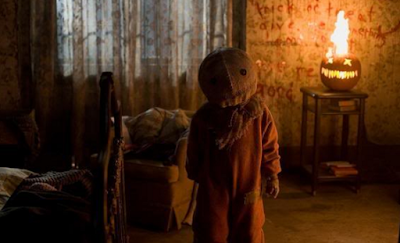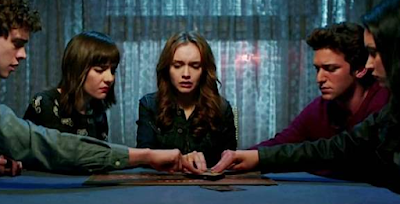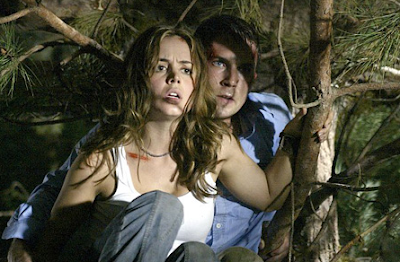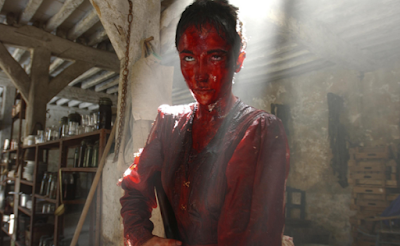(dir. Guillermo del Toro)
 |
| Universal Pictures |
“A house as old as this one becomes, in time, a living
thing.”
Modern horror has lost its sense of romance. When’s
the last time a horror film delivered a truly sweeping story of love? Not
simply sex or a list of check marks performed by characters in a relationship,
not even the sexually charged bond of trust that develops between characters
facing sheer terror. No, I mean the beauty, ugliness, and heartbreak of pure
love, defined in the way that only poetry seems to be able to distill. This is
what maestro of the macabre, Guillermo del Toro, aims to do in his latest film.
He strips away many of the modern trappings of the genre: jump scares, obscured
spectres, quick-tension buildings edits, poorly lit scenes, and leaves horror
bare, so that its beating heart can clearly be seen. In a whirlwind of blood
and snow, Crimson Peak puts the
romance back in horror.
Crimson
Peak
follows the willful and intelligent writer Edith Cushing (Mia Wasikowska) who,
after the death of her father, marries the mysterious inventor and would-be
industrialist, Thomas Sharpe (Tom Hiddleston), who takes her to his manor in an
isolated region of England. Despite warnings from her friend Dr. Alan McMichael
(Charlie Hunnam) and the bristling coldness of Thomas’ sister, Lucille Sharpe
(Jessica Chastain), Mia believes she has found lasting love, that is until the
ghosts appear and the Sharpes’ dark secrets are slowly uncovered.
The narrative of Crimson
Peak is not profoundly different from what audiences could expect to find
in the Victorian Romance novels of the Austen sisters and the Gothic Romances
of Mary Shelley, Edgar Alan Poe, and Henry James. Essentially what del Toro and
co-writer Matthew Robbins have done is take the principal elements of Gothic
literature and present them in a way that only del Toro’s visual sense could
deliver. Those familiar with the Gothic traditions likely won’t be surprised by
the film’s story, but they will be absolutely stunned by the production design,
costumes, and performances, all of which feed off of each other to create a
rich and convincing tapestry that never feels false or overtly constructed. The
actors believe in this world as much as del Toro does, which goes a long way in
making such meticulous fantasy feel like reality
Wasikowska, who is unquestionably one of the most
consistently interesting actresses, completely conveys the outward fragility
and inner strength we’ve come to associate with the heroines of this era. Every
moment of joy, fear, or pain comes across so completely on her face that even
if we know where the story is headed, we are entirely invested in her emotional
discovery. Hiddleston, on the other hand, keeps his emotions close to the vest,
his angular European features creating a figure simultaneously sinister,
broken, alluring, and impenetrable. He is the perfect Byronic figure,
tragically romantic and sure to cause some swooning amongst his fans. Jessica
Chastain rounds out the trio of impeccable performances by the leads as the
spider-like Lucille. Formidable in every sense of the word, it is Chastain’s
performance that very nearly steals the film by the end of it, and I wouldn’t
be the least bit surprised if we see a Supporting Actress campaign circle her
later this year.
And yet, in the midst of these high-profile
performers, the most stunning work comes from production designer Thomas E.
Sanders and costume designer Kate Hawley. It is these aspects that provide the
most consistently rewarding surprises in the film, a mesmerizing frame around
each corner. Every cent of the film’s budget is proudly displayed on the
screen. Every piece of décor, each made specifically for the film, is filled
with detail and color, so much so that the film is at times over-stimulating.
When we’ve seen so many period pieces awash in grays and browns, and so many
horror films that settle for miniscule budgets, it is both refreshing and
necessary to see colorful, lavish, big-budget horror make a return.
But how strong is the horror element in Del Toro’s
quest for love and beauty? Those expecting a Shining-esque level of unease and dread will leave disappointed.
While Crimson Peak certainly has the
grandeur of that film, and includes enough cleverly subversive moments of gore
to earn its R-rating, it ultimately never reaches a level of discomfort. The
ghosts carry del Toro’s signature while looking unlike any ghosts that have
every been seen on film before. They are fleshy yet ethereal, and carry the
wounds of their death in horrific ways, but they are almost always in full view.
If horror relies on what we can’t see and can’t understand, then Crimson Peak fulfills neither
prerequisite. del Toro himself has recently made the claim that the film is not
a horror film, but a gothic romance, sending dozens of film critics into
spiraling debates over the definition of horror. But that definition has little
import in terms of the film’s quality; del Toro may have attempted to spook the
audience, or give them a slight chill, but he never intended to scare them with
monsters. If we look back at the films that started del Toro’s career, Cronos and The Devil’s Backbone, we’ll find that the horror in those films
isn’t a result of the supernatural, but a result of people. These same elements
are prevalent in Gothic horror and while the genre has evolved over the
centuries, Crimson Peak is
unabashedly retroactive. It is emotional fear that defines del Toro’s career,
and it is emotional fear that he delivers here.
Crimson
Peak
is Guillermo del Toro’s love letter to the very foundation of classical horror,
that first seed where all of his Mexican fairy tales, parasitic vampires, and
giant monsters stem from. It’s visually stimulating without feeling emotionally
empty, a perfect example of del Toro’s trademarked phrase “eye protein.” While
similar versions of this story have been told before, the film still manages to
engage and deliver on the promise of being unlike anything we’ve ever seen.
Whether it’s best defined as Gothic Romance or Gothic Horror, Crimson Peak successfully places both back
into the cinematic candlelight.
Grade: A


















